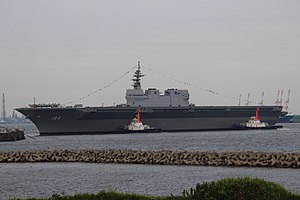JS Kaga

JS Kaga (DDH-184) in August 2015
|
|
| History | |
|---|---|
|
|
|
| Name: | JS Kaga |
| Ordered: | 2010 |
| Laid down: | 7 October 2013 |
| Launched: | 27 August 2015 |
| Commissioned: | 22 March 2017 |
| Identification: | DDH-184 |
| General characteristics | |
| Class and type: | Izumo-class helicopter destroyer |
| Displacement: |
|
| Length: | 248 m (814 ft) |
| Beam: | 38 m (125 ft) |
| Draft: | 7.5 m (25 ft) |
| Propulsion: |
|
| Speed: | more than 30 knots (35 mph; 56 km/h) |
| Sensors and processing systems: |
|
| Electronic warfare & decoys: |
|
| Armament: |
|
| Aircraft carried: |
|
JS Kaga (DDH-184) is a helicopter carrier (officially classified by Japan as a helicopter destroyer) and the second constructed ship in the Izumo class of the Japan Maritime Self-Defense Force (MSDF). Her namesake arises from Kaga Province (加賀国 Kaga no kuni?) in present-day Ishikawa Prefecture.
Kaga is intended to replace the aging Shirane-class destroyer Kurama, based on the schedule outlined within the to construct a 19,500 ton helicopter destroyer. Construction began at the Yokohama plant of Japan Marine United on 7 October 2013, and the ship was launched on 27 August 2015, with plans for commission in March 2017. Construction of the ship cost 115.5 billion yen.
The ship can host up to 28 aircraft, or 14 larger aircraft. However, only 7 anti-submarine warfare helicopters and 2 search and rescue helicopters are planned for the initial aircraft complement. For other operations, 400 troops and 50 3.5-ton trucks (or equivalent equipment) can also be carried. The flight deck has 5 helicopter landing spots that allow simultaneous landings or take-offs.
In 2010, Forecast International reported that some design features were intended to support fixed wing aircraft such as the Bell-Boeing V-22 Osprey and Lockheed Martin F-35 Lightning II; although neither the Ministry of Defense nor the Japanese Maritime Self-Defense Force have mentioned the possibility of introducing fixed-wing aircraft. The ship has neither a "ski-jump" nor a catapult, typical features for launching fixed-wing aircraft. If Izumo-class ships were to operate fixed-wing aircraft, it would be limited to STOVL (short take-off, vertical landing) aircraft, such as the F-35B.
...
Wikipedia
